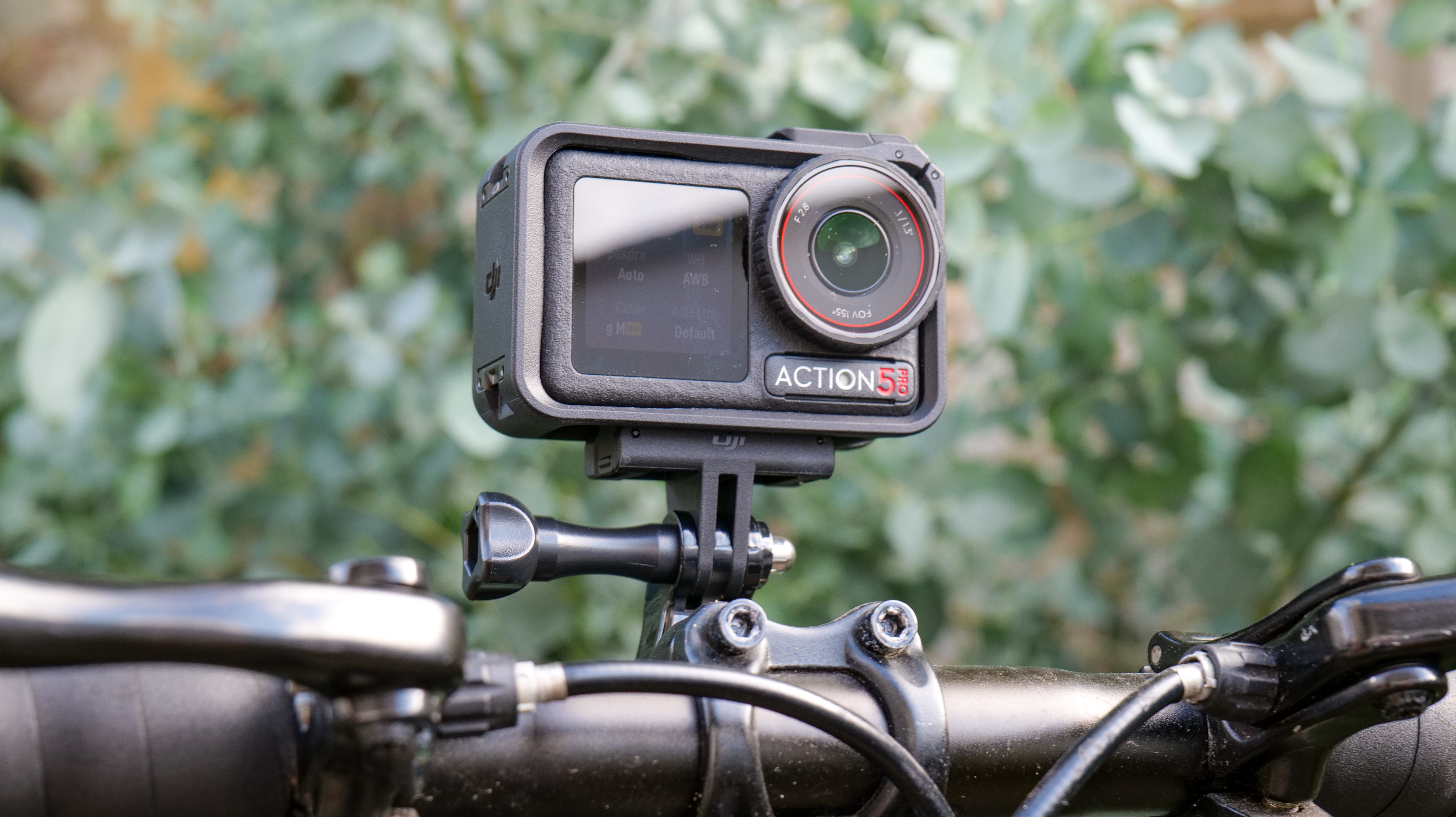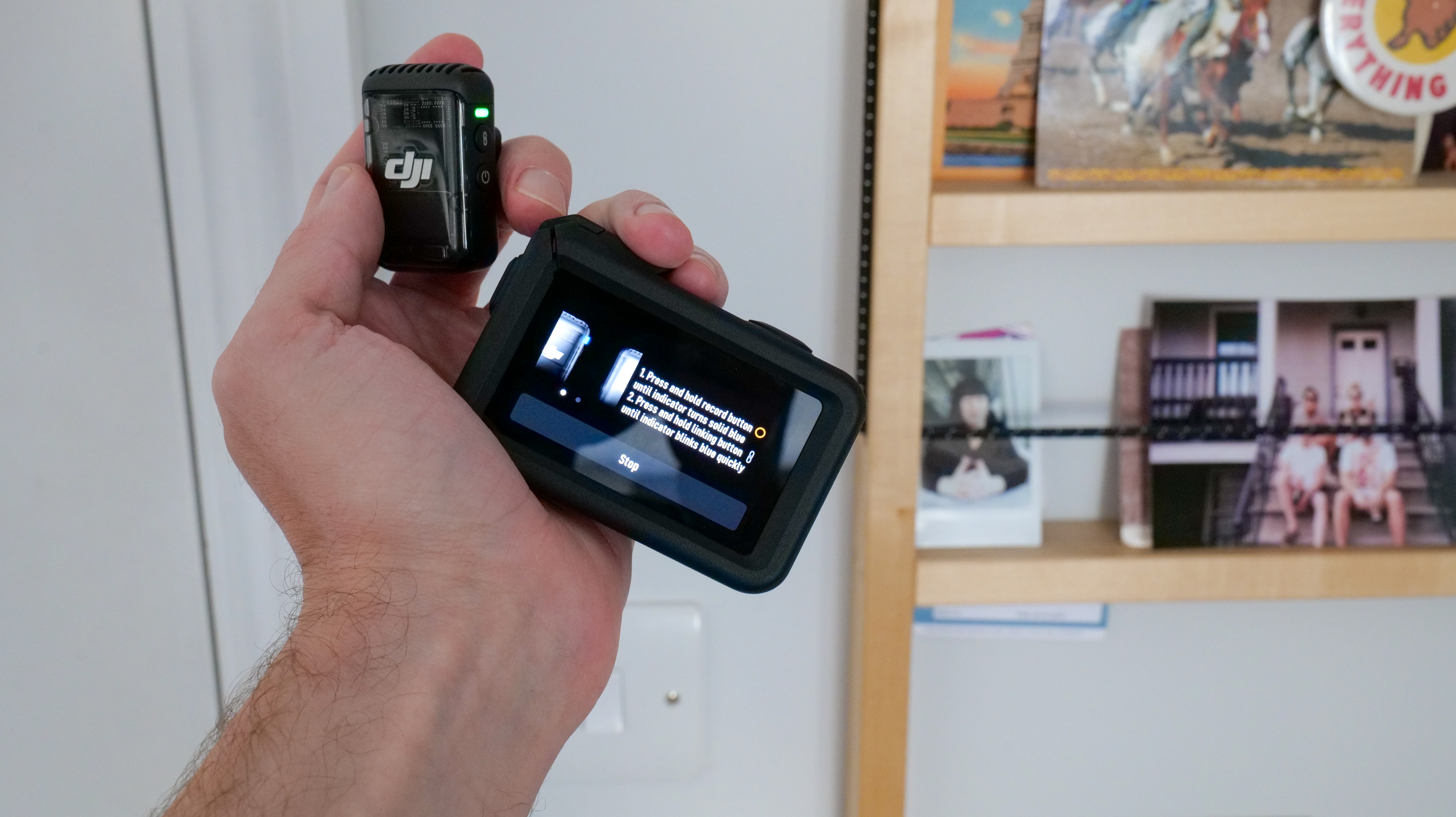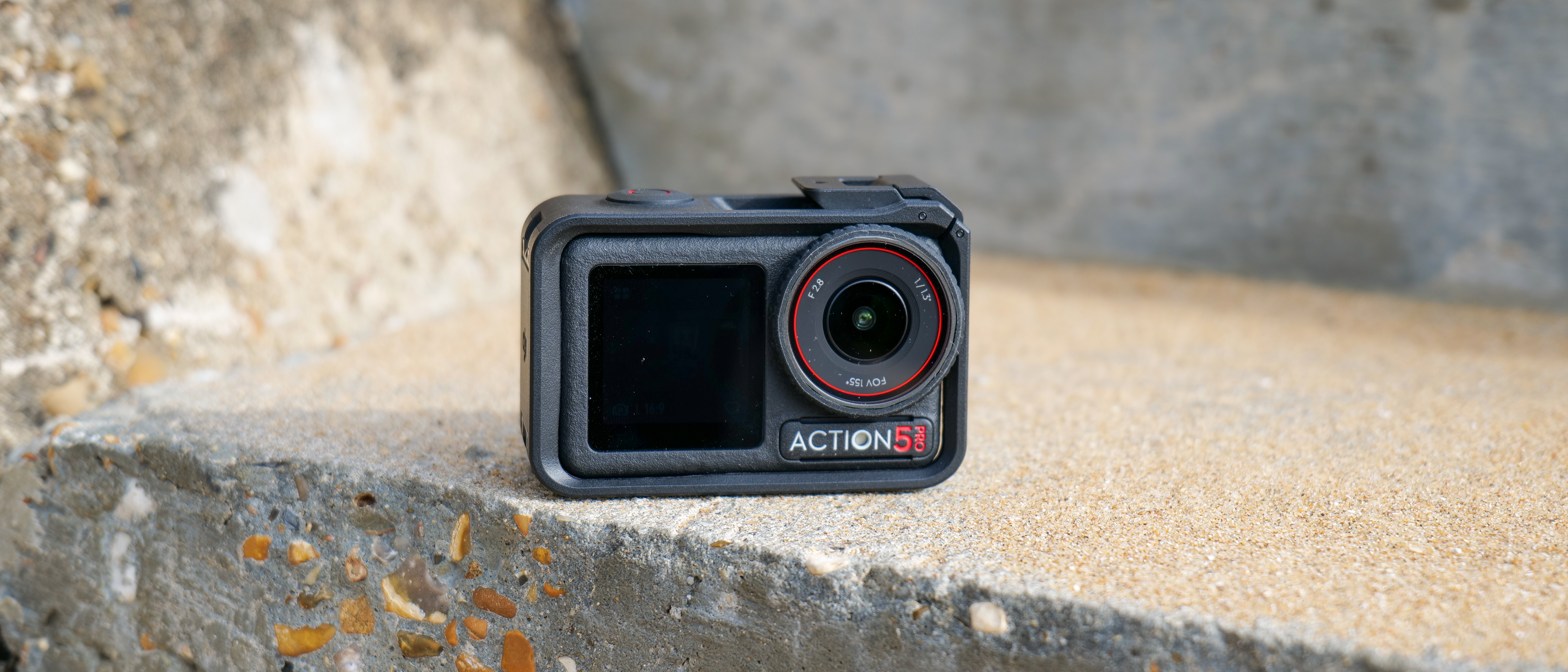TechRadar Verdict
GoPro may remain the de facto action camera market leader, but the Osmo Action 5 Pro proves that relative newcomer DJI is hot on its heels. The Action 5 Pro is more waterproof and freeze-proof than its rivals, its battery life is longer, and its all-round performance is excellent. It also features close compatibility with the DJI Mic 2 for crisp wireless audio, and a range of options and features that make it very useful for general content creators and vloggers. It's a tiny, versatile camera with some serious creative capabilities.
Pros
- +
Good dynamic range and detail
- +
Dual OLED screens
- +
Waterproof to 20m without case
- +
Long battery life
- +
Works superbly with DJI Mic 2
Cons
- -
No 5.3K+ video option
- -
SuperNight mode is merely okay
Why you can trust TechRadar
DJI might be the market leader in consumer drones, but when it comes to action cameras the company remains leagues behind GoPro – at least in the public consciousness. That won’t be the case for long though if it keeps turning out products like the Osmo Action 5 Pro.
Even if nobody should get too excited about the ‘Pro’ moniker – this is currently the only model in the range, so there’s no ‘amateur’ model as yet – the Action 5 Pro is a very impressive action camera, and I had a lot of fun reviewing it. Not only is its image quality superb (in daylight, at least – and even at night it’s still better than a GoPro), but it has long-lasting battery life, effective image stabilization, a rugged lightweight build, two beautifully color-rich OLED screens, and genuinely brilliant compatibility with the DJI Mic 2.

And while it isn’t as mod-friendly as the recent GoPro Hero 13 Black, the Action 5 Pro’s quick-release magnetic mounting system works with all manner of accessories, from helmet and bike mounts to extendable selfie sticks and mini tripods. It can even be used as a webcam.
This versatility means it’ll suit everyone from food vloggers to divers to mountain climbers, and the sheer range of improvements over the Osmo Action 4 suggests that DJI is deadly serious about surpassing the likes of GoPro and Insta360 to establish itself as the leading action camera brand. There’s still a long way to go if that’s going to happen, but if we keep getting cameras like this, it’s a clear possibility.
DJI Osmo Action 5 Pro: release date and price
- Priced at $349 / £329 / AU$599 for the Combo bundle
- Available from September 19 2024
The DJI Osmo Action 5 Pro is available to order now, priced at $349 / £329 / AU$599 for the Standard Combo bundle, which includes the camera, one battery, one protective frame, one quick-release adapter mount, one curved adhesive base, one locking screw, one rubber lens protecter, one glass lens cover, one anti-slip pad and one USB-C to USB-C cable). There's also an Adventure Combo bundle, which is priced at $449 / £409 / AU$769 and includes all of the above plus a mini quick-release adapter mount, one battery case and one 1.5m extension rod.
DJI has priced the Action 5 Pro aggressively: it’s $50 cheaper than the GoPro Hero 13 Black and Insta360 Ace Pro. Given the specs and performance, which I’ll get into below, that’s impressive. (You can read more about how the Action Pro 5 compares to GoPro's latest in our GoPro Hero 13 Black vs DJI Osmo Action 5 Pro article.)
Additionally, a wide range of optional accessories, each sold separately, is available alongside the Action 5 Pro, including mounts, extension rods, GPS units and microphones.
Sign up for breaking news, reviews, opinion, top tech deals, and more.
- Price score: 4.5/5



DJI Osmo Action 5 Pro: design and handling
- Small, lightweight and sturdy build
- Quick-release magnetic mounting system
- Waterproof to 20m without a case
- Front and rear OLED touchscreens
When it comes to rugged reliability, the Osmo Action 5 Pro feels reassuringly well made. The camera itself is small, lightweight (145g) and sturdy, with few protruding parts and a removable, replaceable cover to help prevent damage to the surface of the lens.
It also comes with a frame to further protect the camera body from impact and, while use of this is optional, it adds little to the weight or size of the setup, and leaves buttons and the USB-C chamber fully accessible. In other words, you might as well leave it on all the time. The frame also features mounting points for horizontal and vertical mounting options, allowing you to quickly detach and reattach the camera to magnetic mounts and change orientation for 16:9 or 9:16 shooting as required.
Sensor: 1/1.3” CMOS
Video: Up to 4K/120fps
Photo: 40MP
Screens: 2 x OLED touchscreens
Video modes: Standard, Slo-Mo, SuperNight, Hyperlapse, Subject Tracking
Connectivity: USB-C 3.0, Wi-Fi 6.0, Bluetooth
Weight: 145g
The Action 5 Pro supports the same ‘fingers’ mounting method as GoPro (which means it should be compatible with hundreds of third-party and GoPro-made mounts) while maintaining the magnet-and grip-based quick-release system that previous DJI action cams have used. This setup meant I could unclip the Action 5 from one mount and attach it to another in seconds, rather than having to fuss around with screws and the like. During my review I used a few different mounting systems, including DJI’s own extendable selfie stick and a trio of bike-friendly mounts the company sells. Being able to quickly switch between them all is a godsend.
DJI has buffed the camera’s case-free water resistance even beyond the Osmo Action 4’s impressive 18m depth. The company says the Action 5 can go to 20m (or 65 feet) without a dive case, and 60m with one. That’s double the case-free depth of a GoPro Hero or Insta360 Ace Pro. I wasn’t able to fully test this out myself, but can confirm that it'll take a dunk in the ocean without any ill effects.
The Action 5 Pro also supports a wider range of operating temperatures than its close rivals too, working all the way from -4F / -20C to 113F / 45C. If you’re looking for an all-weather, all-environment consumer camera, this is about as hardy as they come. DJI’s Care Refresh protection plan is available for the camera too, which ensures that you can get a repair or replacement (up to two on a one-year plan, or four on a two-year plan) if the camera suffers accidental damage.


The controls are simple, with only two physical buttons on the camera: a power/mode button on the side and a large shutter/video button on the top. Other settings are accessed either through the touchscreen menus, which are accessible on both the front and rear screens, or via the DJI Mimo mobile app and a paired smartphone. Having tried both methods, I don’t have a preference; both work well and suit different shooting situations, although those with larger fingers might prefer the app due to the small size of the Action 5’s touchscreens.
The screens are in general excellent, though. Now upgraded to OLED, they’re sharp, clear and colorful, and having one on each side of the camera means that properly framing and composing images and videos never feels like a chore; no matter whether you’re self-shooting or filming something in front of you, there’s a screen right there.
- Design score: 4.5/5
DJI Osmo Action 5 Pro: features and performance
- 1950mAh battery
- 47GB of on-board storage plus microSD slot
- RockSteady, RockSteady+ and HorizonSteady image stabilization
- 48kHz Bluetooth recording via DJI Mic 2
DJI makes some bold claims about the Osmo Action 5 Pro’s battery life, saying that a single fully charged 1950mAh battery allows the camera to record up to four hours of video. That’s a 50% improvement over the Osmo Action 4, and DJI says it’s managed this due to the more power-efficient 4nm processor, improvements to battery capacity, and a ‘new algorithm’ that optimizes energy use.
Keen to put these boasts to the test, I set the camera up to record continuously in two video modes: first, 4K at 60fps with RockSteady image stabilization on; then 1080p at 30fps with all stabilization turned off. With the former, a full battery lasted just under two hours – not bad given the relatively high-performance settings. With the latter, it lasted a shade under four hours, just as billed, which is really strong. I should also say that, while the camera was a bit warm to the touch after its two-hour 4K/60fps recording session, it never overheated to the point where it stopped recording.
The Action 5 Pro features a USB-C 3.0 port for in-camera battery charging and file transfer (it also allows the camera to be connected to a computer and used as a plug-and-play webcam). There’s Wi-Fi 6.0 for fast wireless file transfer of up to 80MB/s, which is a big improvement on the Wi-Fi 5.0 of the Action 4; it can also be used for livestreaming, in conjunction with the Mimo mobile app.

On the subject of the Mimo app, while I won’t get too much into it in this review for reasons of space, it’s the same app you may have used with older DJI cameras. It’s basically a great remote control for the Osmo Action 5 Pro, giving you not only access to all the settings and controls but the ability to compose and review your photos and videos on a much larger screen than the camera’s own display. It also lets you share your content quickly via social media and messaging apps.
The camera comes with 47GB of built-in storage (enough for about 80 minutes of 4K/60fps or three hours of 1080p/30fps video), as well as a microSD card slot for expansion. That’s a nice setup in my opinion, as users on the more casual side of things can rely on the internal storage, while the more demanding, heavier users can supplement that with extra cards to ensure they never run out of space.
There are three types of electronic image stabilization on board, as well as the option to turn it off (which, as I’ll get into, you may have good reason to do at times). RockSteady is the basic level; RockSteady+ ups the ante at the cost of a larger crop to the frame; and HorizonSteady keeps the video aligned horizontally (to a point) while applying an even larger crop. They’re all very effective at smoothing and/or levelling video, and I have no complaints about them – even with the crops applied, the field of view remains quite wide.
The camera also embeds non-stabilized videos with gyroscope data, allowing you to stabilize clips yourself in post-production (if you’re wondering why you might do this, it conserves battery life while giving you more control over how stabilization is applied). I tried this using the free GyroFlow plugin for DaVinci Resolve 18 and it works brilliantly (you can see the results in my sample videos). For some reason, you need to select the ‘Wide’ field of view when recording though – the stabilization won’t work if you’ve shot using other settings.

A new feature that social media creators will love (but the rest of us probably won’t touch) is the ability to track and frame a subject (with a TikTok-friendly 9:16 frame) as it moves around in the camera’s field of view. This seems to work with humans only (my cat didn’t register a response), but it does a good job of recognizing someone and keeping them framed. The output 9:16 video then crops out the rest of the frame.
The final feature worth mentioning is the camera’s superb compatibility with the DJI Mic 2. You can wirelessly link up to two DJI Mic 2 transmitters with it via Bluetooth and have them record pristine 48kHz audio, which I found a great way to record clean, clear voiceover or vlog audio, even in windy conditions. It’s the only action camera that currently allows this – other cameras that support the Mic 2 will only support a 16kHz sampling rate, which won’t sound as clear.
- Features and performance score: 5/5
DJI Osmo Action 5 Pro: image and video quality
- Video up to 4K/120fps
- 4K SuperNight mode for low-light shooting
- 10-bit, D-Log M and HLG color profile options
The Action 5 Pro uses the same size 1/1.3-inch sensor as the Action 4, but I found its image quality is a clear step above, with strong dynamic range (DJI claims up to 13.5 stops), and beautifully clean colors and excellent detail in good daylight conditions. Rather than wax lyrical about the image quality, I’ll let you watch the embedded videos (below) and see for yourself. I shot most of the footage here in 4K/60fps using the ‘flat’ D-Log M color profile, color-correcting in post-production with Davinci Resolve 18.
The one exception is the 4K SuperNight sequence, which doesn’t allow D-Log M shooting and limits 4K clips to 30fps; I’ve left this footage untouched to demonstrate how it looks direct from the camera. I wasn’t blown away by SuperNight, and when shooting at night in future I’d be tempted to dial the resolution back to 1080p as the 4K footage doesn’t look particularly sharp. But it does a serviceable job of providing clearer images in low light – a situation where action cameras traditionally struggle.
The fact that the Action 5 Pro doesn’t shoot 5.3K or 8K footage doesn’t bother me much, as in my experience 4K is plenty of resolution for an action camera. That being said, those who like cropping their footage might find the extra detail offered by rival cameras like the GoPro Hero 13 Black or Insta360 Ace Pro handy.
Aside from low-light shooting, the one area where DJI could make improvements in the future is by implementing GoPro-style lens mods. The ability to shoot macro images or insert ND filters could add some extra flexibility to what’s already a very impressive action camera.
- Image quality score: 4/5
DJI Osmo Action 5 Pro: testing scorecard
| Price | Slightly cheaper than its close rivals | 4.5/5 |
| Design | Small and lightweight with great waterproofing | 4.5/5 |
| Features & Performance | Long battery life, great stabilization and good audio options | 5/5 |
| Image and video quality | Superb in good lighting and acceptable in low light | 4/5 |
Should I buy the DJI Osmo Action 5 Pro?
Buy it if...
You want great reliability
Waterproof to 20m, freeze-proof to -25ºC and offering up to four hours of battery life, the Osmo Action 5 Pro is unlikely to let you down.
You own a DJI Mic 2
The pristine 48kHz recording compatibility between this tiny wireless mic and the Action 5 Pro is a game-changer for live voiceover recording. You can even link two mics.
Don't buy it if...
You want crystal-clear night-time footage
DJI’s SuperNight mode may produce better low-light video than most action cameras, but it’s still grainy and lacking in detail compared to video from a mirrorless camera.
You want super high-res footage
4K is fine for 90% of users, but those who need more should look at Insta360 and GoPro’s higher-resolution alternatives.
DJI Osmo Action 5 Pro: also consider
GoPro Hero 13 Black
GoPro’s flagship is a polished performer, recording excellent 5.3K video and supporting a wide range of accessories – including the auto-detected Lens Mods that dramatically widen its creative options. It also features built-in GPS, and finally supports the faster magnetic mounting system already used by rival action cam makers.
Read our GoPro Hero 13 Black review
Insta360 Ace Pro
The Ace Pro is something of a resolution master, offering 8K video (at 24fps) and 4K slow-mo at 120fps from a 1/1.3-inch sensor. Video enthusiasts won’t like the lack of log recording options, however. Design-wise, it sports a large 2.4-inch flip-up touchscreen, eschewing the dual-screen setup favored by GoPro and DJI.
Read our Insta360 Ace Pro

How I tested the DJI Osmo Action 5 Pro
- A week of vlogging and biking
- Paired with DJI Mic 2
- Footage edited using DaVinci Resolve Studio 18.6
I spent a week using a pre-release version of the DJI Osmo Action 5 Pro, capturing vlog-style videos using the including extendable selfie stick and, at times, a paired DJI Mic 2 lavalier microphone. I used DJI’s road cycling mount kit to attach the camera to various points on my bike. I also tested battery life by allowing the camera to continuously record until the battery died.
I recorded video at different resolutions and frame rates, using different color profiles and video modes, and with the various forms of stabilization on or off. Footage was later edited on my PC using DaVinci Resolve Studio 18.6 software, which I used to color-grade and stabilize some clips.
First reviewed September 2024

Sam has been writing about tech and digital culture for over 20 years, starting off in video games journalism before branching out into the wonderful worlds of consumer electronics, streaming entertainment and photography. Over the years he has written for Wired, Stuff, GQ, T3, Trusted Reviews and PC Zone, and now lives on the Kent coast in the UK – the ideal place for a camera reviewer to ply their trade.
